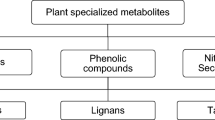Abstract
Cells from Echinacea purpurea (L.) Moench. (Asteraceae), Exacum affine Balf. f. (Gentianaceae), Melittis melissophyllum L. (Lamiaceae), Ruta graveolens L. and Ruta graveolens ssp. divaricata (Tenore) Gams. (Rutaceae) agitating cultures perform a biotransformation reaction on exogenously supplied hydroquinone into its β-D-glucoside — arbutin, product with valuable medicinal and cosmetic properties. The maximum content of arbutin (determined by HPLC) in the biomass from investigated cultures is 4.01; 3.44; 1.79; 2.48 and 5.07 g/100 g d.w., respectively. Nothing but Ammi majus L. (Apiaceae) cultures contain trace amounts of the product. Arbutin is accumulated in cells; it is occasionally found in media only in vestigial amounts. In most of the investigated cultures the efficiency of the biotransformation process is about 60 %.
Similar content being viewed by others
Abbreviations
- BAP:
-
6-benzylaminopurine; biomass-shoots, differentiated callus, undifferentiated callus or cell aggregates from suspension
- d.w.:
-
dry weight
- GA3 :
-
gibberellic acid
- HPLC:
-
high performance liquid chromatography
- LS:
-
medium of Linsmaier and Skoog, 1965
- MS:
-
medium of Murashige and Skoog, 1962
- NAA:
-
α-naphthaleneacetic acid
- PLC:
-
preparative layer chromatography
- s.m.:
-
sucha masa
- TLC:
-
thin layer chromatography
References
Akiu S., Suzuki Y., Fujinuma Y., Asahara T., Fukuda M. 1988. Inhibitory effect of arbutin on melanogenesis: biochemical study in cultured B16 melanoma cells and effect on the UV-induced pigmentation in human skin. Proc. Jpn. Soc. Invest. Dermatol. 12: 138–139.
Dušková J., Dušek J., Jahodá L. 1999. Zur Biotransformation von Hydrochinon zu Arbutin in den In Vitro-Kulturen. Herba Polonica 1: 23–26.
Dušková J., Jahodá L., Dušek J. 1994. Neue Möglichkeiten der Produktion von Arbutin durch Gewebekulturen. Pharmazie 49: 624.
Dušková J., Sovová M., Dušek J., Jahodá L. 1988. The effect of ionizing irradiation on the tissue culture of Arctostaphylos uva-ursi (L.) Sprengel. Pharmazie 43: 518–519.
Ekiert H., Krystian E., Szewczyk A. 2003. Conversion of hydroquinone to arbutin in shoot — differentiating callus culture of Ruta graveolens ssp. divaricata (Tenore) Gams. Polish-Austrian-German-Hungarian-Italian Joint Meeting on Medicinal Chemistry, Kraków, P-223.
European Pharmacopoeia IV. 2002. Council of Europe, Strasbourg: 694–695.
Farmakopea Polska V. 1999. P.T.Farm., Warszawa, Vol. 5: 505–507, 516–518.
Farmakopea Polska VI. 2002. P.T.Farm., Warszawa: 903–904, 908–909.
Furmanowa M., Rapczewska L. 1993. Bergenia crassifolia (L.) Fritsch (Bergenia): Micropropagation and arbutin contents. In: Biotechnology in Agriculture and Forestry. Vol. 21 Medicinal and Aromatic Plants IV. Bajaj Y.P.S. (ed.) Springer-Verlag, Berlin, Heidelberg: 18–33.
Inomata S., Yokoyama M., Seto S., Yanagi M. 1991. High-level production of arbutin from hydroquinone in suspension cultures of Catharanthus roseus plant cells. Appl. Microbiol. Biotechnol. 36: 315–319.
Jahodá L., Vondrová I., Leifertová I., Kolb I., 1982. Tissue culture of Arctostaphylos uva- ursi, examination of phenolic glycosides and isolation of oleanolic acid. Pharmazie 37: 509–511.
Kohlmünzer S. 1998. Farmakognozja. Wydawnictwo Lekarskie PZWL, Warszawa: 233–237.
Linsmaier E.M., Skoog F. 1965. Organic growth factor requirements of tobacco tissue cultures. Physiol. Plant. 18: 100–127.
Lutterbach R., Stöckigt J. 1992. High yield formation of arbutin from hydroquinone by cell-suspension cultures of Rauvolfia serpentina. Helv. Chim. Acta 75: 2009–2011.
Murashige T., Skoog F. 1962. A revised medium for rapid growth and bioassays with tobacco tissue cultures. Physiol. Plant. 15: 473–497.
Newall C.A., Anderson L.A., Phillipson J.D. 1996. Herbal Medicines. A Guide for Health- care Professionals. The Pharmaceutical Press, London: 258–259.
Pi ko -Mirkowa H., Mirek Z. 2003. Flora Polski. Atlas Ro lin Chronionych. Multico Oficyna Wydawnicza, Warszawa: 132–133.
Pilgrim H. 1970. Untersuchungen zur Glykosidbildung in pflanzlichen Gewebekulturen. Pharmazie 25: 568.
Skrzypczak-Pietraszek E., Piekoszewska A. 2002. Biotransformations in in vitro cultures of Exacum affine Balf. f. and Melittis melissophyllum L. International Symposium on Promotion of International Cooperation in Eastern and Southern Europe in the Field of Medicinal Biotechnology, Łód, P-26.
Skrzypczak-Pietraszek E., Szewczyk A., Ekiert H. 2002. Optimisation of biotransformation conditions in Ruta graveolens L. in vitro cultures. 5 Ogólnopolska Konferencja — „Zastosowanie kultur in vitro w fizjologii ro lin” Kraków, p. 68 (in Polish).
Skrzypczak-Pietraszek E., Szewczyk A., Piekoszewska A., Ekiert H. 2004. In vitro cultures of medicinal plants as a potential source of arbutin. Phytotherapie Kongress “Phytopharmaka und Phytotherapie 2004-Forschung und Praxis”, Berlin, p 67.
Štambergov A., Šup ikov M., Leifertov I. 1985. Hodnoceni fenolickýchl tek v Arctostaphylos uva- ursi. IV. Stanoveni arbutinu, metylarbutinu a hydrochinonu v listech metodou HPLC. eskoslov. Farm. 34: 179–182.
Stammwitz U. 1998. Pflanzliche Harnwegsdesinfizienzien — heute noch aktuell?. Z. Phytoth. 19: 90–95
Stöckigt J., Obitz P., Falkenhagen H., Lutterbach R., Endress S. 1995. Natural products and enzymes from plant cell cultures. Plant Cell, Tissue and Organ Culture 43: 97–109
Strapková A., Jahodá L., Nosalová G. 1991. Antitussive effect of arbutin. Pharmazie 46: 611–612.
Suzuki T., Yoshioka T., Tabata M., Fujita Y. 1987. Potential of Datura innoxia cell suspension cultures for glucosylating hydroquinone. Plant Cell Reports 6: 275–278.
Tabata M., Umetani Y., Ooya M., Tanaka S. 1988. Glucosylation of phenolic compounds by plant cell cultures. Phytochemistry 27: 809–813.
Wichtl M. 1997. Teedrogen Und Phytopharmaka. Wissenschaftliche Verlagsgesellschaft mbH., Stuttgart: 599–602.
Wysoki ska H., Chmiel A. 1995. Biotransformacje w kulturach komórek ro linnych. Cz I — Reakcje biotransformacji. Biotechnologia 1: 114–130.
Wysoki ska H., Chmiel A. 2001. Biotransformacje substancji chemicznych. In: Biotechnologia Ro lin. Malepszy S. (ed.) PWN, Warszawa: 144–170.
Yokoyama M., Inomata S. 1998. Catharanthus roseus (Periwinkle): In vitro culture and high-level production of arbutin by biotransformation. In: Biotechnology in Agriculture and Forestry. Vol. 41 Medicinal and Aromatic Plants X. Bajaj Y.P.S. (ed.) Springer, Berlin, Heidelberg, New York: 67–80.
Yokoyama M., Inomata S., Seto S., Yanagi M. 1990. Effects of sugars on the glucosylation of exogenous hydroquinone by Catharanthus roseus cells in suspension culture. Plant Cell Physiol. 31: 551–555.
Author information
Authors and Affiliations
Rights and permissions
About this article
Cite this article
Skrzypczak-Pietraszek, E., Szewczyk, A., Piekoszewska, A. et al. Biotransformation of hydroquinone to arbutin in plant in vitro cultures — preliminary results. Acta Physiol Plant 27, 79–87 (2005). https://doi.org/10.1007/s11738-005-0039-x
Received:
Accepted:
Issue Date:
DOI: https://doi.org/10.1007/s11738-005-0039-x




